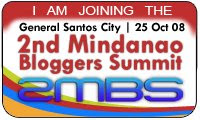
COMMUNITY PROFILE.
(from the Briefer of ACT For Peace Programme - StRIDE Mindanao Project)
Barangay Gasi is one of the 30 community-beneficiaries of the StRIDE Mindanao Project implemented by Kapayapaan Kapatid Council. One of the 19 barangays comprising the Municipality of Kiamba, Province of Sarangani - it is an upland barangay three (3) kilometers away from the Maitum-General Santos National Highway and twelve (12) kilometers from the seat of the municipality. It is bounded on the North by T'boli, South Cotabato, on the East by Barangay Maligang, on the West by Barangay Datu Dani, and on the South by Barangay Kling.
The road leading to the barangay poblacion is accessible to all forms of transportation but mostly motorcycles ("habal-habal") are plying the route. Some of its interior sitios are less accessible and can only be reached by foot or by horse. It has a population of 323 households or 1,736 individuals, and is composed of seven (7) sitios, namely: Macao, Sog, Kawayan, Lehek, Salvan, Lao, and Kapanal. Majority of the residence are T'boli(85%) while the rest are mixed etnicity, viz: Cebuano, B'laan, and Maguindanaon. Farming is the main source of livelihood and most of the farm lots are apportioned to corn, coconut, abaca, and other cash crops.
CONFLICT BACKGROUND:
On October 4, 2008 at around 2-3AM, social infrastructure in Barangay Gasi were burned down by traversing armed groups, to include: Barangay Hakk; Day care center; Barangay Stage; "Tindahan sa Kalinaw" (store for peace); and waiting shed. The only structure within the compound that was spared from the fire was the barangay health station.
 Number of families affected are as follows: Sitio Kapanal (96 families); Sitio Kawayan (30 families); Sitio Lehek (54 families); Sitio Macao (51families); Sitio Salvan(25 families); Sitio Sog(29 families)
Number of families affected are as follows: Sitio Kapanal (96 families); Sitio Kawayan (30 families); Sitio Lehek (54 families); Sitio Macao (51families); Sitio Salvan(25 families); Sitio Sog(29 families)Majority of those displaced already resettled in their respective places of origin, however, the incident left trauma to the community folks. Compounded by economic, social, and political marginalization - much is left to be done in terms of rehabilitating the community. Poverty abounds in the area. Although 98% (591 of 606)o f those engaged in agricultural production owned the area they till, they lack technology and inputs to intensify their production. A small group of women is organized on the handicraft of nito weaving and basketry but at the substinence level only. Illiteracy rate is also high with percentage rate of 8% (elementary level graduates) and 4% (secondary level graduates) per 2009 survey. Early preganancies are rampant (as early as 13 years old) - this is ascribed to their cultural orientation.
f those engaged in agricultural production owned the area they till, they lack technology and inputs to intensify their production. A small group of women is organized on the handicraft of nito weaving and basketry but at the substinence level only. Illiteracy rate is also high with percentage rate of 8% (elementary level graduates) and 4% (secondary level graduates) per 2009 survey. Early preganancies are rampant (as early as 13 years old) - this is ascribed to their cultural orientation.
 f those engaged in agricultural production owned the area they till, they lack technology and inputs to intensify their production. A small group of women is organized on the handicraft of nito weaving and basketry but at the substinence level only. Illiteracy rate is also high with percentage rate of 8% (elementary level graduates) and 4% (secondary level graduates) per 2009 survey. Early preganancies are rampant (as early as 13 years old) - this is ascribed to their cultural orientation.
f those engaged in agricultural production owned the area they till, they lack technology and inputs to intensify their production. A small group of women is organized on the handicraft of nito weaving and basketry but at the substinence level only. Illiteracy rate is also high with percentage rate of 8% (elementary level graduates) and 4% (secondary level graduates) per 2009 survey. Early preganancies are rampant (as early as 13 years old) - this is ascribed to their cultural orientation.INTEGRATED REHABILITATION ACTIVITIES AT GASI

Key Activities done in Gasi:
1. Delivery of Core Services and Livelihood Support
a. Installation of level 2 water system
b. Construction of barangay health station (including provision of basic equiptments and essential medicines)
c. Establishment of Botika ng Barangay
d. Farm implements to facilitate return, resettlement and reintegration
e. Livelihood provision for women.
f. Supplemental feeding for 122 children.
g. Construction of multi-purpose building classroom
h. Provision of quick impact livelihood - support to agricultural production
i. construction of 20 units core shelter
j. integrated health and nutrition program - immunization/vitamin supplemntation (3 cycles)
2. Trauma counselling and rehabilitative services provision of psychosocial services for men, women and children.
3. BAWASA/NASATrainings/WASH Operation and Maintenance/PO capability; conflict resolution and management trainings; stress defriefings

Barangay Health Station. BHS include the birthing room, consultation room, nurses/reception station, records/stock room, waiting area, 2 toilet & bath. The floor area is 8.4m x 9.4m. The BHS has also new medical equiptments and medecines.




